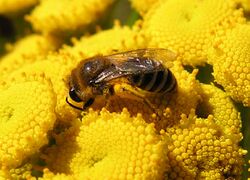Biology:Colletidae
| Colletidae | |
|---|---|

| |
| Colletes daviesanus | |
| Scientific classification | |
| Domain: | Eukaryota |
| Kingdom: | Animalia |
| Phylum: | Arthropoda |
| Class: | Insecta |
| Order: | Hymenoptera |
| Clade: | Anthophila |
| Family: | Colletidae Lepeletier, 1841 |
| Subfamilies | |
| |
The Colletidae are a family of bees, and are often referred to collectively as plasterer bees or polyester bees, due to the method of smoothing the walls of their nest cells with secretions applied with their mouthparts; these secretions dry into a cellophane-like lining.[1] The five subfamilies, 54 genera, and over 2000 species are all (with the known exception of but one species, Amphylaeus morosus)[2] evidently solitary, though many nest in aggregations. Two of the subfamilies, Euryglossinae and Hylaeinae, lack the external pollen-carrying apparatus (the scopa) that otherwise characterizes most bees, and instead carry the pollen in their crops. These groups, and most genera in this family, have liquid or semiliquid pollen masses on which the larvae develop.
They can be found all over the world, but the most species live in South America and Australia. Over 50% of all bee species living in Australia belong to this family.[3] Only the genera Colletes and Hylaeus can be found in Europe, while in the Western Hemisphere, in addition to these two, the genera Caupolicana, Eulonchopria, and Ptiloglossa are found.
Australian genera include Euhesma, a large genus, members of which has been split off into other genera such as Euryglossa and Callohesma.[4]

Traditionally, this family is believed to be likely the most "primitive" among extant bees, based primarily on the similarities of their mouthparts (the unique possession among bees of a bilobed glossa) to those of Crabronidae (the putative ancestors of bees), but recent molecular studies have disproved this hypothesis, placing the Melittidae (sensu lato) as the basal group of bees.[5]
"Nocturnal" species
The Colletidae are one of the four bee families that contain some crepuscular species (of both the "vespertine" and "matinal" types). These bees, as is typical in such cases, have greatly enlarged ocelli. The other families with some crepuscular species are Andrenidae, Halictidae, and Apidae.
Systematics
- Subfamily Colletinae — worldwide
- Tribe Paracolletini
- Brachyglossula
- Callomelitta
- Chrysocolletes
- Eulonchopria
- Glossurocolletes
- Hesperocolletes
- Hesperocolletes douglasi
- Leioproctus
- Lonchopria
- Lonchorhyncha
- Neopasiphae
- Niltonia
- Paracolletes
- Phenacolletes
- Trichocolletes
- Tribe Colletini
- Colletes
- Mourecotelles
- Tribe Scraptrini
- Scrapter
- Tribe Paracolletini
- Subfamily Diphaglossinae — Americas
- Tribe Caupolicanini
- Caupolicana
- Crawfordapis
- Ptiloglossa
- Tribe Diphaglossini
- Cadeguala
- Cadegualina
- Diphaglossa
- Tribe Dissoglottini
- Mydrosoma
- Mydrosomella
- Ptiloglossidia
- Tribe Caupolicanini
- Subfamily Xeromelissinae — tropical Americas
- Chilicola
- Chilimelissa
- Geodiscelis
- Xenochilicola
- Xeromelissa
thumb|Hylaeus sp. on Allium flower.
- Subfamily Hylaeinae — yellow-faced bees,[6] worldwide
- Amphylaeus
- Calloprosopis
- Hemirhiza
- Hylaeus
- Hyleoides
- Meroglossa
- Palaeorhiza
- Xenorhiza
- Subfamily Euryglossinae — Australian
- Brachyhesma
- Callohesma
- Dasyhesma
- Euhesma
- Euryglossa
- Euryglossina
- Euryglossula
- Heterohesma
- Hyphesma
- Melittosmithia
- Pachyprosopis
- Sericogaster
- Stenohesma
- Tumidihesma
- Xanthesma
References
- ↑ C. D. Michener (2007) The Bees of the World, 2nd Edition, pg. 133, Johns Hopkins University Press.
- ↑ "Strange bee-haviour: Social life of Australian species offers insights on evolution, scientists say". 15 June 2022. https://www.theguardian.com/environment/2022/jun/15/strange-bee-haviour-social-life-of-australian-species-offers-insights-on-evolution-scientists-say.
- ↑ Slattery, Patricia S.; Parslow, Ben A.; Lee, Michael S. Y.; Batley, Michael; Walker, Ken L.; Schwarz, Michael P. (2023-02-28). "Disparate continental scale patterns in floral host breadth of Australian colletid bees (Colletidae: Hymenoptera)" (in en). Apidologie 54 (2): 17. doi:10.1007/s13592-023-00996-z. ISSN 1297-9678. https://doi.org/10.1007/s13592-023-00996-z.
- ↑ Michener, Duncan Charles (2000). The bees of the world. JHU Press. pp. 216–7. ISBN 978-0-8018-6133-8. https://books.google.com/books?id=bu_1gmY13FIC&q=Euhesma&pg=PA217. Retrieved 8 December 2010.
- ↑ Danforth, B.N.; Sipes, S.; Fang, J.; Brady, S.G. (2006). "The history of early bee diversification based on five genes plus morphology". Proc Natl Acad Sci U S A 103 (41): 15118–23. doi:10.1073/pnas.0604033103. PMID 17015826. Bibcode: 2006PNAS..10315118D.
- ↑ "Encyclopedia of Life entry for Hylaeinae". http://eol.org/pages/2741222/overview.
External links
Wikidata ☰ Q132340 entry
 |

